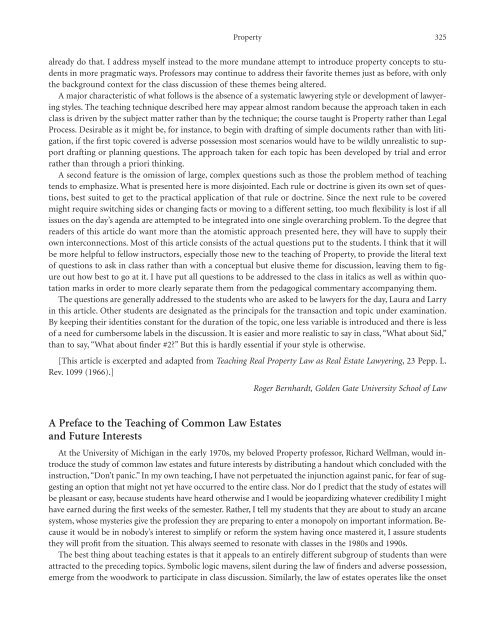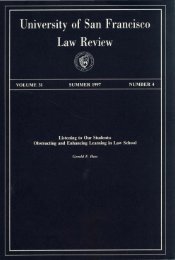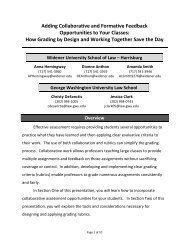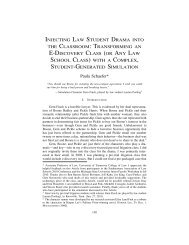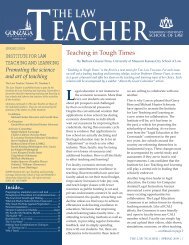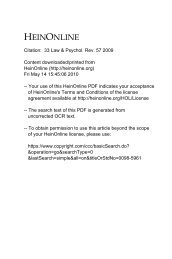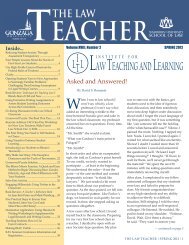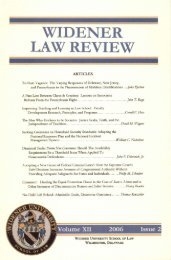Teaching the Law School Curriculum - Institute for Law Teaching ...
Teaching the Law School Curriculum - Institute for Law Teaching ...
Teaching the Law School Curriculum - Institute for Law Teaching ...
You also want an ePaper? Increase the reach of your titles
YUMPU automatically turns print PDFs into web optimized ePapers that Google loves.
Property 325<br />
already do that. I address myself instead to <strong>the</strong> more mundane attempt to introduce property concepts to students<br />
in more pragmatic ways. Professors may continue to address <strong>the</strong>ir favorite <strong>the</strong>mes just as be<strong>for</strong>e, with only<br />
<strong>the</strong> background context <strong>for</strong> <strong>the</strong> class discussion of <strong>the</strong>se <strong>the</strong>mes being altered.<br />
A major characteristic of what follows is <strong>the</strong> absence of a systematic lawyering style or development of lawyering<br />
styles. The teaching technique described here may appear almost random because <strong>the</strong> approach taken in each<br />
class is driven by <strong>the</strong> subject matter ra<strong>the</strong>r than by <strong>the</strong> technique; <strong>the</strong> course taught is Property ra<strong>the</strong>r than Legal<br />
Process. Desirable as it might be, <strong>for</strong> instance, to begin with drafting of simple documents ra<strong>the</strong>r than with litigation,<br />
if <strong>the</strong> first topic covered is adverse possession most scenarios would have to be wildly unrealistic to support<br />
drafting or planning questions. The approach taken <strong>for</strong> each topic has been developed by trial and error<br />
ra<strong>the</strong>r than through a priori thinking.<br />
A second feature is <strong>the</strong> omission of large, complex questions such as those <strong>the</strong> problem method of teaching<br />
tends to emphasize. What is presented here is more disjointed. Each rule or doctrine is given its own set of questions,<br />
best suited to get to <strong>the</strong> practical application of that rule or doctrine. Since <strong>the</strong> next rule to be covered<br />
might require switching sides or changing facts or moving to a different setting, too much flexibility is lost if all<br />
issues on <strong>the</strong> day’s agenda are attempted to be integrated into one single overarching problem. To <strong>the</strong> degree that<br />
readers of this article do want more than <strong>the</strong> atomistic approach presented here, <strong>the</strong>y will have to supply <strong>the</strong>ir<br />
own interconnections. Most of this article consists of <strong>the</strong> actual questions put to <strong>the</strong> students. I think that it will<br />
be more helpful to fellow instructors, especially those new to <strong>the</strong> teaching of Property, to provide <strong>the</strong> literal text<br />
of questions to ask in class ra<strong>the</strong>r than with a conceptual but elusive <strong>the</strong>me <strong>for</strong> discussion, leaving <strong>the</strong>m to figure<br />
out how best to go at it. I have put all questions to be addressed to <strong>the</strong> class in italics as well as within quotation<br />
marks in order to more clearly separate <strong>the</strong>m from <strong>the</strong> pedagogical commentary accompanying <strong>the</strong>m.<br />
The questions are generally addressed to <strong>the</strong> students who are asked to be lawyers <strong>for</strong> <strong>the</strong> day, Laura and Larry<br />
in this article. O<strong>the</strong>r students are designated as <strong>the</strong> principals <strong>for</strong> <strong>the</strong> transaction and topic under examination.<br />
By keeping <strong>the</strong>ir identities constant <strong>for</strong> <strong>the</strong> duration of <strong>the</strong> topic, one less variable is introduced and <strong>the</strong>re is less<br />
of a need <strong>for</strong> cumbersome labels in <strong>the</strong> discussion. It is easier and more realistic to say in class, “What about Sid,”<br />
than to say, “What about finder #2?” But this is hardly essential if your style is o<strong>the</strong>rwise.<br />
[This article is excerpted and adapted from <strong>Teaching</strong> Real Property <strong>Law</strong> as Real Estate <strong>Law</strong>yering, 23 Pepp. L.<br />
Rev. 1099 (1966).]<br />
A Preface to <strong>the</strong> <strong>Teaching</strong> of Common <strong>Law</strong> Estates<br />
and Future Interests<br />
Roger Bernhardt, Golden Gate University <strong>School</strong> of <strong>Law</strong><br />
At <strong>the</strong> University of Michigan in <strong>the</strong> early 1970s, my beloved Property professor, Richard Wellman, would introduce<br />
<strong>the</strong> study of common law estates and future interests by distributing a handout which concluded with <strong>the</strong><br />
instruction, “Don’t panic.” In my own teaching, I have not perpetuated <strong>the</strong> injunction against panic, <strong>for</strong> fear of suggesting<br />
an option that might not yet have occurred to <strong>the</strong> entire class. Nor do I predict that <strong>the</strong> study of estates will<br />
be pleasant or easy, because students have heard o<strong>the</strong>rwise and I would be jeopardizing whatever credibility I might<br />
have earned during <strong>the</strong> first weeks of <strong>the</strong> semester. Ra<strong>the</strong>r, I tell my students that <strong>the</strong>y are about to study an arcane<br />
system, whose mysteries give <strong>the</strong> profession <strong>the</strong>y are preparing to enter a monopoly on important in<strong>for</strong>mation. Because<br />
it would be in nobody’s interest to simplify or re<strong>for</strong>m <strong>the</strong> system having once mastered it, I assure students<br />
<strong>the</strong>y will profit from <strong>the</strong> situation. This always seemed to resonate with classes in <strong>the</strong> 1980s and 1990s.<br />
The best thing about teaching estates is that it appeals to an entirely different subgroup of students than were<br />
attracted to <strong>the</strong> preceding topics. Symbolic logic mavens, silent during <strong>the</strong> law of finders and adverse possession,<br />
emerge from <strong>the</strong> woodwork to participate in class discussion. Similarly, <strong>the</strong> law of estates operates like <strong>the</strong> onset


